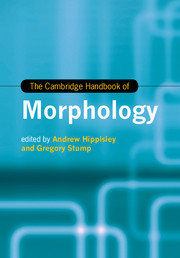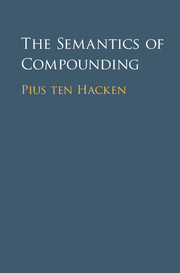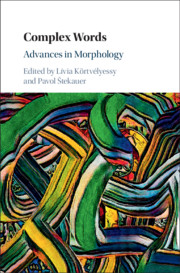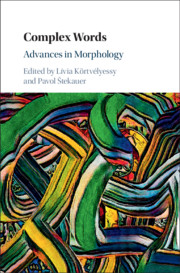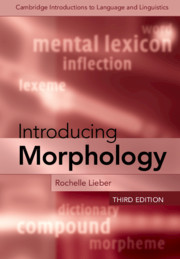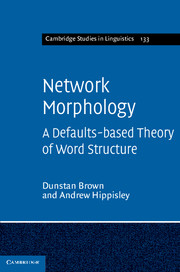The Cambridge Handbook of Morphology
The Cambridge Handbook of Morphology describes the diversity of morphological phenomena in the world's languages, surveying the methodologies by which these phenomena are investigated and the theoretical interpretations that have been proposed to explain them. The Handbook provides morphologists with a comprehensive account of the interlocking issues and hypotheses that drive research in morphology; for linguists generally, it presents current thought on the interface of morphology with other grammatical components and on the significance of morphology for understanding language change and the psychology of language; for students of linguistics, it is a guide to the present-day landscape of morphological science and to the advances that have brought it to its current state; and for readers in other fields (psychology, philosophy, computer science, and others), it reveals just how much we know about systematic relations of form to content in a language's words - and how much we have yet to learn.
- The first Handbook to survey the full theoretical landscape of contemporary morphology and reliably elucidate the main issues in the field
- Covers typological description and a variety of theoretical interpretations, allowing readers to see how the linkage between data and theory varies according to the fundamental assumptions one makes about the nature of morphology
- Includes the most current research topics, such as the quantification of linguistic complexity, the nature of morphomic patterns and the significance of paradigms as an object of morphological inquiry
Reviews & endorsements
"Wide-ranging and comprehensive, this volume is a welcome addition to the reference volumes currently available in the field of linguistic morphology. Covering everything from general theoretical issues, contemporary frameworks, and interfaces with phonology and syntax to computational, experimental, and psycholinguistic approaches, it will be a valuable resource to linguists and scholars in related fields."
Rochelle Lieber, University of New Hampshire
"A fine wide-ranging overview, carefully planned and well executed. It is packed with analysis and insight, demonstrating the substantial progress that morphologists have made over recent years. This timely book will be invaluable not only to morphologists, but also to syntacticians and phonologists."
Greville G. Corbett, Surrey Morphology Group
"The Cambridge Handbook of Morphology provides a rich and up-to-date compendium of the problems that morphology poses for descriptive and theoretical linguistics, and of the ways in which linguists have tried to approach those problems; the volume will be invaluable to morphologists as a definition of the state of the art, and to other linguists interested in entering or keeping up with this field."
Bernard Comrie, University of California, Santa Barbara
Product details
January 2017Hardback
9781107038271
878 pages
255 × 182 × 42 mm
1.86kg
19 b/w illus.
Available
Table of Contents
- 1. Introduction Andrew Hippisley and Gregory Stump
- Part I. Foundations of Morphological Theory:
- 2. Two morphologies or one? Inflection versus word-formation Andrew Spencer
- 3. The minimal sign: morpheme or lexeme James Blevins
- 4. Productivity Georgette Dal and Fiammetta Namer
- Part II. Issues in Morphological Theory:
- 5. Alternations: stems and allomorphy Mary Paster
- 6. Morphological semantics Paolo Acquaviva
- 7. Affix ordering: motivation and interpretation Marianne Mithun
- 8. The place of morphology Mark Aronoff
- 9. The status of paradigms Gilles Boyé and Gauvain Schalchli
- Part III. Morphological Principles:
- 10. Lexicalism, the principles of morphology-free syntax and syntax-free morphology Paul O'Neill
- 11. Defaults and overrides in morphological description Dunstan Brown
- 12. Implicative relations in word-based morphological systems Farrell Ackerman and Rob Malouf
- Part IV. Morphological Frameworks:
- 13. Classical morphemics: assumptions, extensions and alternatives Laurie Bauer
- 14. Natural morphology Wolfgang U. Dressler and Marianne Kilani-Schoch
- 15. Distributed morphology Martha McGinnis-Archibald
- 16. Construction morphology Geert Booij
- 17. Paradigm function morphology Olivier Bonami and Gregory Stump
- 18. Network morphology Andrew Hippisley
- Part V. The Role of Morphology in Theories of Phonology and Syntax:
- 19. The role of morphology in generative phonology, autosegmental phonology and prosodic morphology Sharon Inkelas
- 20. The role of morphology in optimality theory Zheng Xu
- 21. The role of morphology in transformational grammar and its descendants Stephen Anderson
- 22. The role of morphology in constraint-based lexical grammars Olivier Bonami and Berthold Crysmann
- 23. The role of morphology in dependency grammar Richard Hudson
- Part VI. Domains for the Evaluation of Morphological Theories:
- 24. Frequency and corpora Péter Rácz, Viktória Papp and Jennifer Hay
- 25. Morphology in linguistic typology Johanna Nichols
- 26. Morphology in language change Brian Joseph
- 27. Morphology and language acquisition Constantine Lignos and Charles Yang
- 28. Experimental morphology Harald Clahsen
- 29. Computational morphology Lynne Cahill.

